THE BLIND HARPIST'S ODE TO SPRING
18th-Century Music, Crafts and Cooking Highlight Historical Society's Annual Family Fete
By Hoag Levins ...| ...April 28, 2002
CAMDEN, N.J. -- It's difficult to say whether the most memorable part of yesterday's Family Fun Day at the Camden County Historical Society was the
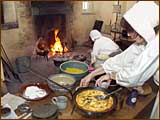
|
| Photo: Hoag Levins. |
|
Hazel Werner (at fire) and Cheryl McClain (foreground) prepare yesterday's hearth-cooked meal.
|
|
sound of the blind harpist, the aroma of skewered ham sizzling over open flames or the taste of 'hand-rolled' ice cream.
Beyond that there was a juggler and tight-rope walker upstairs, a woman spinning raw silk into yarn in the front parlor, and an ongoing scurry of authentically costumed docents that gave the sprawling mansion and museum complex the air of a Colonial Williamsburg event.
By midafternoon, as they shoveled more embers atop cast iron dutch oven lids, members of the sweating kitchen staff noted it was the most heavily attended and colorful spring event the Society had ever held.
Vibrating Pomona Hall
In fact, Pomona Hall, the restored mansion that was the eighteenth-century home of one of southern New Jersey's wealthiest family, literally vibrated around its visitors. From every room and hallway one could hear the melodies of the three-piece traditional wooden instrument band, Flagstone. Played in the central chamber of the 214-year-old building, the unamplified sounds of harp, dulcimer and mandolin were surprisingly robust.
Comprised of Janice Steinbeck of Marlton, Kurt Jung
of Mount Laurel and Wes Steenson of Philadelphia, Flagstone performed "The Greatest Hits of the Eighteenth Century," which is where the part about blind harpist comes in.
The most haunting of the group's sounds were those of Turlough O'Carolan, an early eighteenth-century harpist and composer who has become something of a patron saint for modern-day acoustical music aficionados.
Blind harpist
Born in Ireland in 1670, O'Carolan was left blind by a bout of smallpox when he was 18. But he went on to become a skilled harpist and wandering minstrel who wrote songs for wealthy landowners who hired him to perform in their castles and mansions. By the time he died in 1738, the blind harpist left behind more than 200 original compositions that are today among the sounds most commonly recognized as "Irish" music.
"O'Carolan's work was very popular throughout the British Isles and the songs traveled to America with the colonists," said Jung, Flagstone's harpist. "They were regularly played in the homes of eighteenth-century Americans, including here in South Jersey."
Along with O'Carolan, Flagstone strummed out a mix of other period English country dances and classical works throughout the day.
"One of the reasons it's so much fun to perform this stuff," said Steenson who plays mandolin and guitar, "is that the
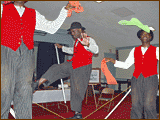
|
| Photo: Hoag Levins. |
|
Performance artist Kevyn Terrill Johnson of Upper Darby, Pa., kept children clapping in the auditorium.
|
|
architecture in a period house like Pomona Hall becomes an integral part of the performance."
"The acoustics in this place are amazing -- you can feel Kurt's harp vibrating through the floor, and the surrounding wood and curved arches make the sound so rich and resonant," he said. "What you're hearing is exactly what the Cooper family would have heard 200 years ago when they had musicians playing the same music here."
Sizzled ham
Along with historic music, the Society's Family Fun Day also featured educational demonstrations of colonial domestic crafts, including the preparing of real meals over a roaring wood fire.
"The menu today is bread pudding, corn with bacon, ham, corn bread and apple pie," explained chief colonial cook, Hazel Werner. Earlier in the day, as assistants tended a fire stoked with chunks of oak, Werner jammed metal pokers through a huge ham, strung it up with steel wire and hung it close to the flames on a special twisting device. As its outside sizzled crispy brown, the meat was occasionally basted with a mix of honey and brown sugar. Later, when sliced up and served to the crowd, it tasted as good as it smelled.
But ham wasn't the real culinary star of the day -- the 'hand-rolled' ice cream was.
Coffee-can ice cream
Ten years ago, Ms. Werner first used coffee cans as miniature ice cream makers in the Sunday school class
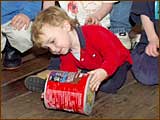
|
| Photo: Hoag Levins. |
|
A young visitor rolls his ice cream-making coffee can.
|
|
she taught. "Everyone really enjoyed it," she said, "and when we were thinking about how to make this year's Family Fun Day different, we thought hand-rolled ice cream might work well here as well."
And it certainly did.
Throughout the afternoon, small groups of children were invited to work as teams with a three-pound coffee can and a one-pound coffee can. They were shown how to combine milk, heavy cream, sugar and vanilla in the small can, then snap on its plastic top.
Then, the small can was put into the larger can and the surrounding space packed tight with crushed ice and rock salt. After the plastic lid was snapped on, the children were encouraged to roll the can back and forth across the broad wooden plank floor of the open hearth kitchen. After twenty minutes of rolling, the cans were opened and team members got to eat the results of their labor: incredibly rich ice cream.
"Kids are always surprised when you open up the can and there really is ice cream in there," Ms. Werner said. "Then they taste it and soon their parents are tasting it. It's great fun."
In fact, by late afternoon the floor of the large kitchen was occupied by more adults than children patiently rolling their Maxwell House and Chock-Full-of-Nuts cans back and forth in eager anticipation.
Spun silk
Spinning, always one of the more population
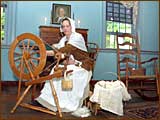
|
| Photo: Hoag Levins. |
|
Terry Burrows spins silk in the front parlor of Pomona Hall.
|
|
attractions at the Society, was being demonstrated in the front parlor of Pomona Hall by Terry Burrows of Lindenwold. A semi-circle of baskets at her feet was full of raw silk and mohair, which she turned into yarn as she quietly answered the crowd's questions.
"I got interested in doing this about ten years ago," she said. "I work with the same materials as 18th-century spinners," she explained. "Some visitors today are surprised to hear that I'm spinning silk but wealthier colonial families imported silk; their more common neighbors used wool or flax. A lot of the kids love to watch this and try to figure out what I'm actually doing. At first, they don't know if this is weaving or what and then they get to see the yarn appear. It's very educational as well as a lot of fun."
History expo
For the first time since it started its annual Family Fun Day five years ago, the Society expanded the event to include a mini-expo showcasing displays from other historical sites around the county. In the large auditorium of the Boyer Library building, tables were manned by costumed docents from Pennsauken's Griffith Morgan House, Lawnside's Peter Mott House & Underground Railroad Museum and Cherry Hill's Barclay Farmstead Museum,
"This has really been helpful," said Linda Waller, President
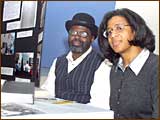
|
| Photo: Hoag Levins. |
|
'We hope they do more of this,' said Linda Waller with Clinton Higgs, Jr, at the Peter Mott House expo booth yesterday.
|
|
of the Lawnside Historical Society, who was manning the Peter Mott House display with Clinton Higgs, Jr. "We're meeting new people who have an interest in local history and making contacts we otherwise wouldn't have made. We hope they do more of this."
At the Griffith Morgan display, Kay Rudderow, who helps manage that historic homestead, was also pleased with Sunday's expo. "Years ago, the county used to get the various historic site people together on a regular basis and it was a great way to exchange information and help each other with ideas and tips, but then it stopped," she said. "This new Camden County Historical Society program is a great idea. After all, we all have the same kinds of problems at our sites and it really makes sense to help each other promote our facilities."
One couple browsing the Griffith Morgan table was Bill and Arlene Ezekiel who have lived in Aududon for 11 years and in Haddon Heights for 26 years before that. "We take a lot of history tours," said Mrs. Ezekiel, "but neither of us had heard about either the Griffith Morgan or the Peter Mott House before."
The Ezekiels have previously visited the Camden County Historical Society to do genealogical research in its library, but had never before toured its mansion or museum.
"We brought our daughter and granddaughter today because of the activities described in the newspaper story," Mrs. Ezekiel said. "We read that the spinner was going to be giving a demonstration and our granddaughter had never seen a spinning wheel before, so we said, 'Wow, let's do it.' She's really enjoyed watching that and the hearth cooking."
"It's amazing how much is here to see and learn," she said, noting that with eight children and 17 grandchildren she expected to be back soon.
| 




